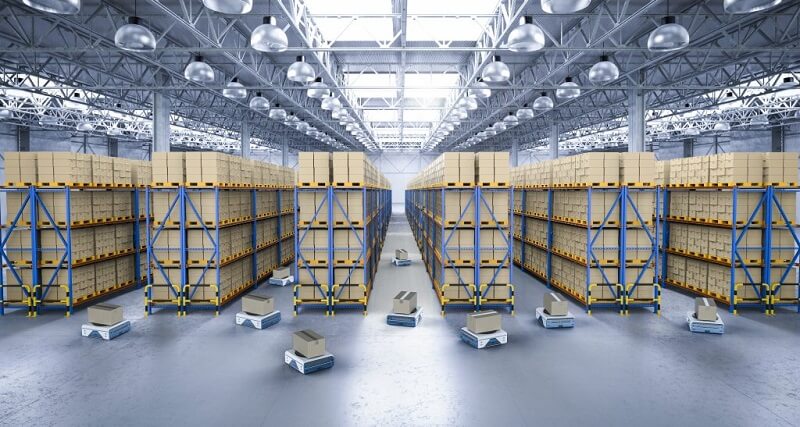Ecommerce Warehouse Management Systems – What to Look For?

Warehouse management sounds like one of those modern concepts. It brings up connotations to something that arose from standardization and technology.
It’s not really.
Warehouses have been an essential part of trade activities since the time of antiquity. It was as important a concept back then as it is right now.
Are you an eCommerce business owner? Well, then your primary concern should be your eCommerce inventory management.
Ecommerce inventory management is crucial. It keeps your products organized and helps you save massive time in product sourcing. That is, when it’s done right.
In addition, with high performance systems organized on your store, you can keep your customers happy.
In this post, we’ll be discussing eCommerce warehouse management and everything related to it. If you’re just starting out, make sure to read the full article.
If you already know the basics you can skip ahead to the eCommerce warehouse management system essentials section.
Okay, so let’s begin.
What Is Ecommerce Warehousing?

Ecommerce warehousing is all about the storage of physical goods in a specific location to be shipped out when an order has been placed for them.
Ecommerce warehouse management can give your business the competitive edge when done right.
“Done right”, that’s the keyword here.
Some of the most common activities that take place in an eCommerce warehouse (or for that matter, a general warehouse) include:
- Warehouse maintenance aka managing the safety and security of the warehouse itself.
- Storing and sorting inventory within the warehouse.
- Managing shelves, isles, bins, and locations for each product category and sub-category.
- Basic eCommerce inventory management by keeping track of what’s coming in and what’s going out of an eCommerce store.
- Monitoring stock levels and inventory
- Maintaining inventory levels to prevent stock outs.
Inventory holding is an essential aspect of eCommerce operations management. The costs associated with them can be optimized, but cannot be ruled out entirely without focusing on them at a deeper level.
Warehouse Management Systems

One of the best ways you can optimize your operational costs for warehousing is through using a Warehouse Management System (WMS).
The primary benefit to using a WMS is that it creates a powerful warehouse. Because of the boost in productivity. As a direct consequence, you also increase your profit margins significantly.
A WMS system, when connected with your other office backend systems like the ERP, OMS, and AMS, can create an ecosystem with real time information.
With the right stock and inventory information available, you can make decisions more accurately and forecast stock options better.
But those are all external benefits.
Externally, your customers can also benefit from WMS. Through real time data on stock levels and the exact order information, your customers can get helpful support for their purchase.
The final benefit, of course, is optimized costs. WMS provides your business with the most optimized use of your labor resources.
Now the Warehouse Management System you select for your eCommerce store matters a lot. It’s not just limited to a single platform, there’s more that you can do.
There are plenty of considerations you need to look at before selecting one.
Read Also: 5 Golden Rules of Warehouse Management
In the next section of this post, I’ll be explaining the nine things you should consider before selecting an eCommerce store.
Eight Things to Consider When Choosing an Ecommerce Warehouse Management System

There is no one size fits all solution when it comes to selecting a warehouse management system.
Different business, different needs.
As such, you need a unique solution that’s there to stay. You don’t want a shiny WMS that doesn’t seem to function in the coming years.
If you’re looking to avoid falling into such a trap, then there are certain considerations that you need to take into account beforehand.
Let’s look at some of them, shall we?
Before we begin, let us just point out that unless you’re getting your feet off the ground, you shouldn’t worry about the price. If a certain WMS is fulfilling all your requirements but it’s expensive, then purchase it.
Convenience should be the long-term goal for you as opposed to short term cost cutting.
With that out of the way, let’s start:
Ensure Your WMS is Up to Date
Your WMS systems should provide you with accuracy all the way.
Again, you don’t want a system that doesn’t record your inventory transactions properly.
You need something that is accurate with as little room for error as possible. We place an emphasis on accuracy. This is because one single mistake within the inventory management process can make the entire store network swell up.

Training
The WMS software provider that you select must provide excellent training programs. This helps equip warehouse workers with the skills needed to get up and running with the software.
The system should be easy to use from the get-go. However, there is no denying the importance of providing the right training. It helps workers adopt it without facing any sort of stress and error.
Scalability
It might seem as though the eCommerce industry is very saturated. While that is a case to a certain degree, there’s still room for your business to flourish.
But if you’re looking to pose a challenge to the giants within the industry, you must have a system that lets you grow as your business improves.
The right WMS helps you improve your business processes from the backend.
With that efficiency you can go the distance. When you’ve optimized both the front and back offices, you can pose a serious threat to the position of your competitors.
Data
The modern digital landscape runs on the use of efficient data. How you use your data to make decisions is important.
With the right inventory data at your disposal, you can make accurate demand forecasts accurately for your business.
Return on Investment
Purchasing a WMS for your eCommerce store is a business consideration.
As such, you need to have the right numbers and financials before you make a case for purchasing.
As reiterated before, you don’t want an WMS system that leaves you scratching your head.
Some of them are one’s that look cheap but come with additional costs. Those costs include maintenance, customization, and other resources that can make the costs rise.
On-site vs Cloud
One of the biggest questions’ businesses ask before selecting a WMS is whether they want to go on site or on the cloud.
These are crucial considerations that can matter a lot in the long run. You can go for an on-site platform and build it using your own office resources. In addition to that, you can also go for custom software development services that help build your custom WMS for you.
Generally, a cloud WMS costs less and manages things for you from its back end. This Software as a Service (SaaS) model can come in handy for businesses. If you don’t want to incur labor costs or an in-house development team for their businesses, then go for SaaS.
Integration and Interfacing
The main benefit you can gain from the right CMS is the fact that it will connect with your existing back-office software with relative ease. For your business, try to find a solution that already has support for a variety of different integrations.
Our B2B eCommerce platform, B2BWoo comes equipped with a variety of integrations from the get-go. From Microsoft Dynamics to SAP and others. The primary reason behind these integrations is to make it easy for the user to get started with their b2b journey.
Real-Time Data and Warehouse Activity Records
With the correct WMS platform available at your disposal, you can get real time with regards to your inventory levels.
This helps you make the right decisions with regards to your inventory management efforts. The more refined your data points, the better decisions you can make.
Look for a platform that can provide you superior analytics and data points to make good decisions.
We’ve talked about the best practices for selecting the right WMS platform. Now, it’s time we move on to the next step of warehouse management: it’s best practices.
Ecommerce Warehousing Best Practices

When you’ve set up your eCommerce store, you need to manage the warehouse where you’ll stock your products as well. Now when you’re managing the warehouse, there are certain best practices that you need to take into account.
With these best practices you can improve your bottom line significantly.
1. Use an Ecommerce Warehouse Management System (WMS)
After all we’ve discussed this one’s a given. With a specialized eCommerce WMS software at your disposal, you can gain supreme business efficiency.
They provide real time data and analytics, help you monitor and manage your business activities, forecast inventory. It also streamlines your inventory fulfillment processes, among other things.
When you select the right platform, you’re gaining serious benefits for your business processes.
2. Distribute Your Inventory
When you distribute your inventory across a variety of different areas, you’re reducing your business costs.
This results in quick order fulfillment. This, in turn, improves the customer service for your brand as well as providing a cost-effective delivery.
3. Test Multiple Picking Systems to Find the Right One
Picking refers to the amount of time taken to pick up an order for delivery. With the right data, you can select pick up points from where you can select the right places for your product.
4. Set Inventory Minimums Points
Finding and maintaining the correct inventory balance is always a challenge.
Order too much from the supplier and you risk delivering a possibly spoiled or expired product. Order too little and you’re left with stocks out which are even more harmful in the long run.
The ideal is to maintain balance in your offerings. Make sure you maintain a threshold for your inventory points and try to not go above or below it.
Connect with experts at CODUP for top-notch eCommerce website development services.
Conclusion:
With warehouse management, efficiency and high performance are the key. With the right software and the right training for your workforce, you can improve the efficiency of your business to deliver a high-quality eCommerce experience.




